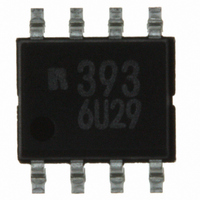LM393DR Rohm Semiconductor, LM393DR Datasheet - Page 6

LM393DR
Manufacturer Part Number
LM393DR
Description
IC COMPARATOR DUAL 0.8MA 8-SOIC
Manufacturer
Rohm Semiconductor
Series
Trophyr
Type
General Purposer
Datasheet
1.LM393DR.pdf
(8 pages)
Specifications of LM393DR
Number Of Elements
2
Output Type
CMOS, MOS, Open-Collector, TTL
Voltage - Supply
2 V ~ 36 V, ±1 V ~ 18 V
Mounting Type
Surface Mount
Package / Case
8-SOIC (0.154", 3.90mm Width)
Mounting Style
SMD/SMT
Comparator Type
General Purpose
No. Of Comparators
2
Response Time
1.3µs
Ic Output Type
CMOS, MOS, TTL
Output Compatibility
CMOS, MOS, TTL
Supply Current
800µA
Supply Voltage Range
5V To 30V
Rohs Compliant
Yes
Lead Free Status / RoHS Status
Lead free / RoHS Compliant
Other names
LM393DRTR
Available stocks
Company
Part Number
Manufacturer
Quantity
Price
Company:
Part Number:
LM393DR
Manufacturer:
TI
Quantity:
100 210
Part Number:
LM393DR
Manufacturer:
TI/德州仪器
Quantity:
20 000
Part Number:
LM393DR2
Manufacturer:
ON/安森美
Quantity:
20 000
Company:
Part Number:
LM393DR2G
Manufacturer:
ON
Quantity:
100 000
Part Number:
LM393DR2G
Manufacturer:
ON/安森美
Quantity:
20 000
Description of Electrical Characteristics
Described below are descriptions of the relevant electrical terms.
Please note that item names, symbols, and their meanings may differ from those on another manufacturer’s documents.
1. Absolute maximum ratings
1.1 Power supply voltage (Vcc/GND)
1.2 Differential input voltage (VID)
1.3 Input common-mode voltage range (VICR)
1.4 Operating temperature range and storage temperature range (Topr,Tstg)
1.5 Power dissipation (Pd)
2. Electrical characteristics
2.1 Input offset voltage (VIO)
2.2 Input offset current (IIO)
2.3 Input bias current (IIB)
2.4 Input common-mode voltage range (VICR)
2.5 Large signal differential voltage gain (AVD)
2.6 Supply current (ICC)
2.7 Low level output current (IOL)
2.8 Low level output voltage (VOL)
2.9 High level output current (IOH)
2.10 Response time (tre)
2.11 Common-mode rejection ratio (CMRR)
2.12 Power supply rejection ratio (PSRR)
The absolute maximum ratings are values that should never be exceeded, since doing so may result in deterioration of electrical
characteristics or damage to the part itself as well as peripheral components.
Expresses the maximum voltage that can be supplied between the positive and negative power supply terminals without causing
deterioration of the electrical characteristics or destruction of the internal circuitry.
Indicates the maximum voltage that can be supplied between the non-inverting and inverting terminals without damaging the IC.
Signifies the maximum voltage that can be supplied to non-inverting and inverting terminals without causing deterioration of the electrical
characteristics or damage to the IC itself. Normal operation is not guaranteed within the input common-mode voltage range of the maximum
ratings – use within the input common-mode voltage range of the electric characteristics instead.
The operating temperature range indicates the temperature range within which the IC can operate. The higher the ambient temperature,
the lower the power consumption of the IC. The storage temperature range denotes the range of temperatures the IC can be stored under
without causing excessive deterioration of the electrical characteristics.
Indicates the power that can be consumed by a particular mounted board at ambient temperature (25°C). For packaged products, Pd is
determined by maximum junction temperature and the thermal resistance.
Signifies the voltage difference between the non-inverting and inverting terminals. It can be thought of as the input voltage difference
required for setting the output voltage to 0V.
Indicates the difference of the input bias current between the non-inverting and inverting terminals.
Denotes the current that flows into or out of the input terminal, it is defined by the average of the input bias current at the non-inverting
terminal and the input bias current at the inverting terminal.
Indicates the input voltage range under which the IC operates normally.
The amplifying rate (gain) of the output voltage against the voltage difference between the non-inverting and inverting terminals, it is
(normally) the amplifying rate (gain) with respect to DC voltage.
AVD = (output voltage fluctuation) / (input offset fluctuation)
Indicates the current of the IC itself that flows under specific conditions and during no-load steady state.
Denotes the maximum current that can be output under specific output conditions.
Signifies the voltage range that can be output under specific output conditions.
Indicates the current that flows into the IC under specific input and output conditions.
The interval between the application of input and output conditions.
Denotes the ratio of fluctuation of the input offset voltage when the in-phase input voltage is changed (DC fluctuation).
CMRR = (change of input common-mode voltage) / (input offset fluctuation)
Signifies the ratio of fluctuation of the input offset voltage when the supply voltage is changed (DC fluctuation).
PSRR = (change in power supply voltage) / (input offset fluctuation)
6/8
TROPHY SERIES LM2903/2901/393/339 family
These Products are designed and produced by ROHM.









